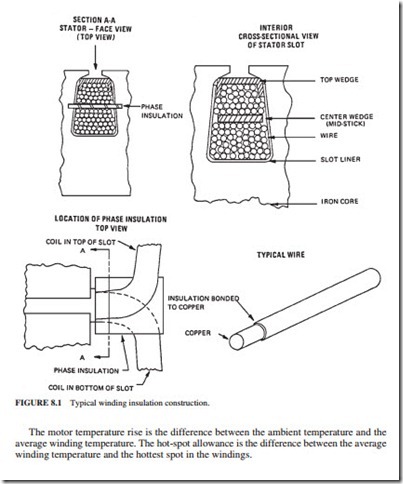INSULATION OF AC MOTORS
The quality of the maintenance and the insulation system have a significant impact on the overall service life and performance of a motor. The main factors in increasing the life of the insulation system are to keep it clean, dry, and cool. The insulation systems (Fig. 8.1) in motors include the following:
1. Turn insulation. This basic wire coating is an enamel, resin, film, or film-fiber com- bination used to electrically insulate adjacent wire turns from one another within a coil.
2. Phase insulation. Sheet material is used to insulate between phases at the coil end turns.
3. Ground insulation (slot liners). Sheet material is used to line the stator slots and insulate the stator winding from stator iron or other structural parts.
4. Midstick (center wedge). Insulation is used in stator slots to separate and insulate coils from one another within the slot.
5. Topstick (top wedge). This is used to compact and contain the coil wires within the stator slots.
6. Lead insulation. Insulation materials surround lead wires.
7. Lacing and tape. These are used to tie lead wires in place on the stator end coils. Also they are used to tie end coils together, adding mechanical strength to the end coils and restricting their movement.
8. Varnish. Varnish treatment is employed to increase the resistance of the completely wound stator to environmental attack of chemicals, moisture, etc. The varnish treatment bonds the coils, connections, wedges, and stator iron into an integrated structure and improves the components’ resistance to electrical and mechanical damage.
In modern motors rated above 500 hp, a vacuum pressure impregnation (VPI) system is used for the insulation. The benefits are a void-free sealed insulation system with high mechanical strength and thermal conductivity. The ground wall insulation of this system always contains some form of mica tape. The varnishes used in normal atmospheric dipping are substituted by a 100 percent solids resins. The stator is placed in a large vacuum pressure tank. Resins are impregnated into the stator and windings by alternately applying vacuum and pressure while the stator is fully immersed in resin. The resins are made of polyester, or epoxy. However, epoxy provides greater strength and higher resistance to abrasion or chemicals such as acids and alkalies. The VPI provides a better seal in wet and corrosive atmospheres. The absence of voids reduces the losses due to corona (partial discharge) at higher voltages.
